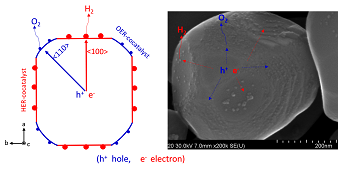A research paper on Nature: Photocatalyst that can split water into hydrogen and oxygen at a quantum efficiency close to 100%
2020.05.29
A research team led by Shinshu University’s Tsuyoshi Takata, Takashi Hisatomi and Kazunari Domen succeeded in developing a photocatalyst that can split water into hydrogen and oxygen at a quantum efficiency close to 100%. The team consisted of their colleagues from Yamaguchi University, The University of Tokyo and National Institute of Advanced Industrial Science and Technology (AIST).
The team produced an ideal photocatalyst structure composed of semiconductor particles and cocatalysts. H2 and O2 evolution cocatalysts were selectively photodeposited on different facets of crystalline SrTiO3(Al-doped) particles due to anisotropic charge transport. This photocatalyst structure effectively prevented charge recombination losses, reaching the upper limit of quantum efficiency.

This study refined the design and operating principle for advancing water splitting methods with a high quantum efficiency. The knowledge obtained in this study will propel the field of photocatalytic water splitting further to enable the scalable solar hydrogen production.
(Images:Structure and function of the developed photocatalyst for efficient water splitting.)
This study was reviewed in News & Views and selected as a Hot Topic with the same issue and journal.
The project was made possible through the support of NEDO (New Energy and Industrial Technology Development Organization) under the "Artificial photosynthesis project".
Title: Photocatalytic water splitting with a quantum efficiency of almost unity
Authors:Tsuyoshi Takata, Junzhe Jiang, Yoshihisa Sakata, Mamiko Nakabayashi, Naoya Shibata, Vikas Nandal, Kazuhiko Seki, Takashi Hisatomi, Kazunari Domen
Journal:Nature, 581, 411-414 (2020)
DOI10.1038/s41586-020-2278-9
News & Views article
Title: An almost perfectly efficient light activated catalyst for producing hydrogen from water
Author: Simone Pokrant
Journal: Nature, 581, 386-388 (2020)
DOI 10.1038/d41586-020-01455-w